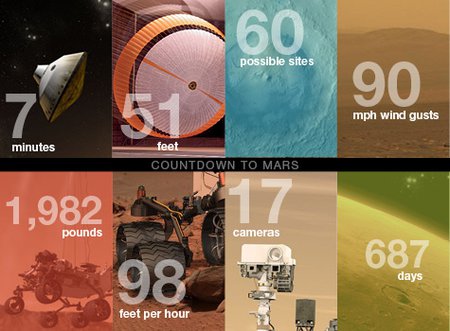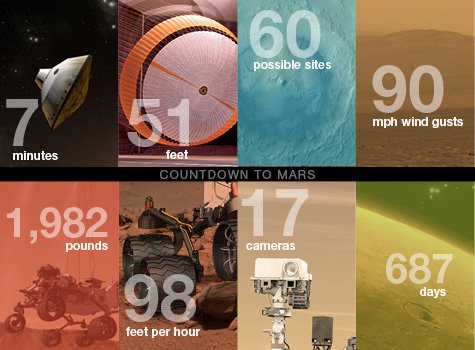Since launching in November 2011, NASA's Mars Science Laboratory (MSL) has been traveling full steam ahead on a journey that will traverse over 350 million miles, ending on the Red Planet at 10:31 p.m. on Sunday, August 5. Tucked into a spacecraft for safekeeping during flight, MSL contains a rover named Curiosity. As part of a long-term effort of robotic exploration, the rover's mission is to determine the planet's habitability. If everything goes as planned, Curiosity—which was designed, built, and tested at JPL—will become the fourth rover to survey Mars.
Here are some more facts about Curiosity and the mission:
The estimated length of time it will take the rover to make its entry, descent, and landing on Mars once it arrives at the Red Planet's atmosphere: About seven minutes. Dubbed the "seven minutes of terror" by NASA, MSL will employ a parachute, landing rockets, a hovering sky crane, and other complicated mechanisms to help lower the rover to the surface of Mars.
The diameter of the parachute that will assist in Curiosity's landing: 51 feet. Made from white and orange material, the parachute will bring Caltech colors to the Red Planet.
Landing site: The rover will land near the base of Mount Sharp, inside Gale Crater. Mount Sharp, a layered mountain that rises three miles above the crater floor, was named to honor the late Caltech geologist Bob Sharp (BS '34, MS '35).
The number of possible landing sites scientists considered before deciding on Gale Crater: 60. Gale Crater was chosen because it is thought to contain elements that are important to the search for the ingredients of life.
Weather on Mars: Cold and windy with wind gusts of up to 90 mph—as strong as some hurricane winds on Earth. Mars is home to dust storms and quickly moving whirlwinds known as dust devils. Temperatures on the planet can get as cold as minus 199 degrees Fahrenheit.
Curiosity's mass: 1,982 pounds. The rover has a mass close to that of a MINI Cooper, but it is more like a small SUV in size.
Speed of Curiosity: On average, the rover is expected to travel across the surface of Mars at about 30 meters (98 feet) per hour, based on power levels, slippage, steepness of the terrain, visibility, and other variables.
The number of cameras on Curiosity: 17. The rover also has 10 scientific instruments (some of which are part of the group of 17 cameras) to do many of the tasks scientists do in a lab. Instead of sending samples back to Earth for humans to analyze, the Curiosity rover will thus be able to do laboratory tests right from the Martian surface.
Length of Curiosity's robotic arm: Seven feet. The arm is capable of collecting powdered samples from rocks, scooping soil, preparing and delivering samples for analytic instruments, and brushing surfaces on the planet.
Time on Mars: The plan is for Curiosity to operate on the surface of Mars for one Martian year. A Martian year is equal to 98 weeks, or 687 days, on Earth.
 Credit: NASA/JPL-Caltech
Credit: NASA/JPL-Caltech

